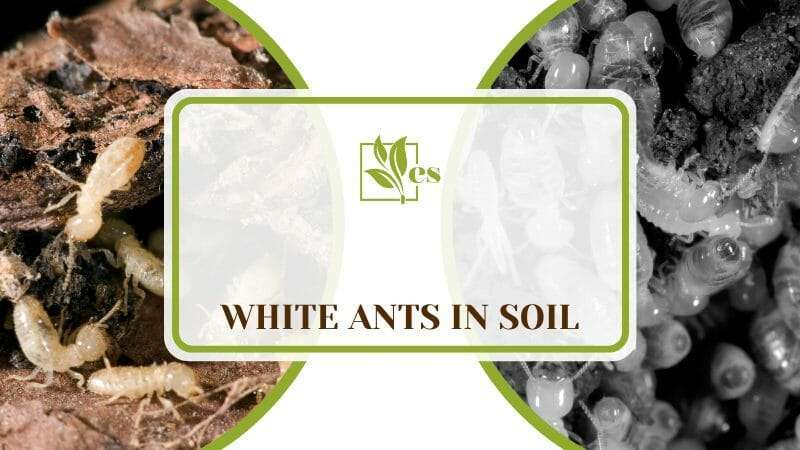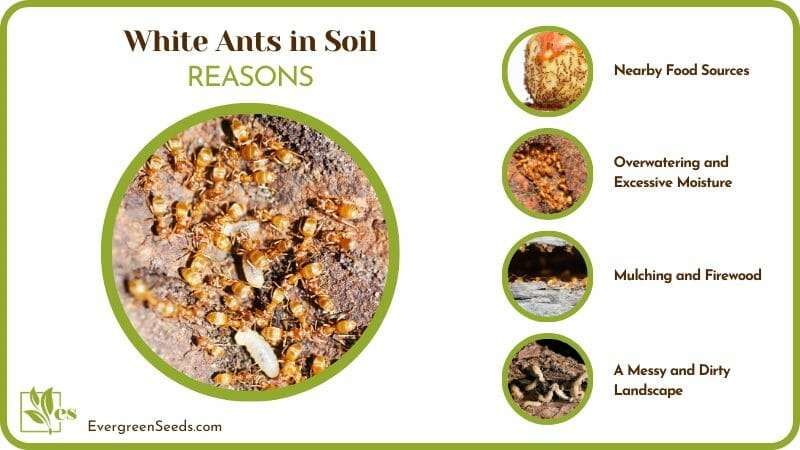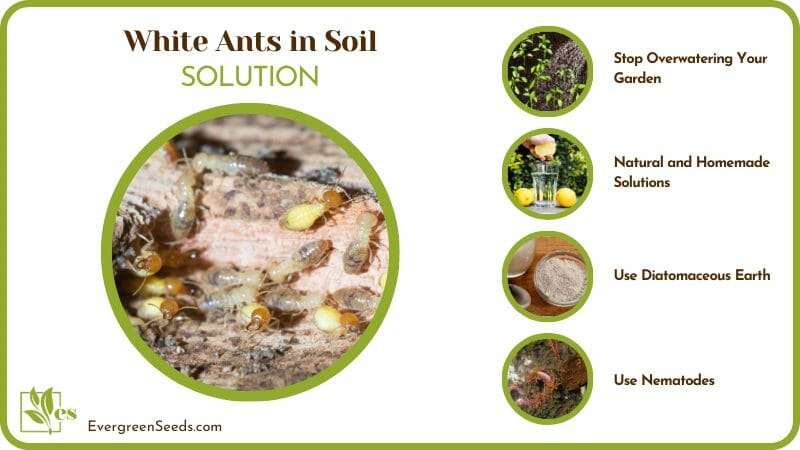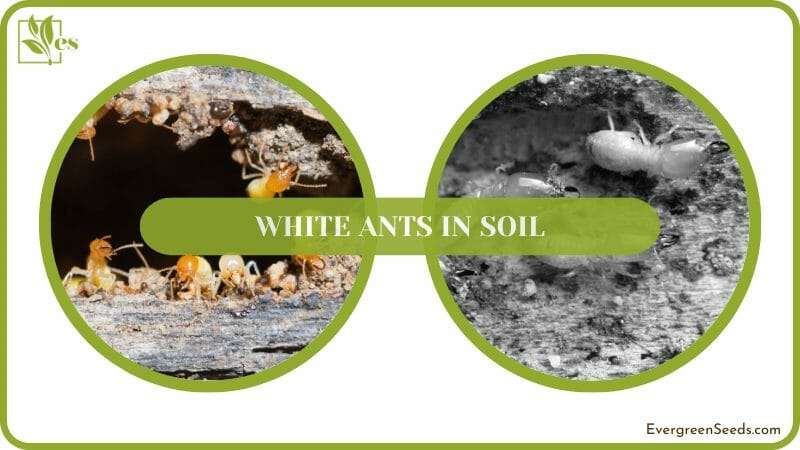White ants in soil commonly refer to all types of termites in garden soil. White ants will prepare their nests in the garden soil – they live on the soil’s nutrients and deprive the plants of essential nutrients.

Thus, your plants will grow slowly, and some may even die. Thankfully, there are both homemade and commercial ways to treat white ants and remove them.
JUMP TO TOPIC
What Causes White Ants in Soil?
Causes of white ants in soil include having nearby food sources, overwatering, mulching and firewood, and problematic basements. If you see white ants in the soil, it most likely indicates a termite infestation in your garden and home – this is a serious matter.
But why do white ants come into your garden soil? What attracts them the most? To safeguard your landscape from a white ant infestation, you must find the actual reasons for their infestation. Then, you may eradicate the problem more quickly.
– Nearby Food Sources
White ants are naturally attracted to cellulose-rich fibers and food items. Thus, their infestation in the garden and home means they have found a food source nearby. Their food sources are almost always rich in cellulose. Thus, white ants live primarily on wood and wood fiber.
If your landscape has piles of dead wood, tree stems, and stumps lying outdoors, they can quickly attract termites. In fact, tree stumps and wood piles are the primary reasons for the infestation of soil in your garden. You can hollow out and preserve a tree trunk to stop the ant infestation.
Both the piles of dead wood and tree stumps are rich in cellulose. So, they work as the primary source of food for termites. Naturally, they will swarm into your garden. Thus, these nearby food sources are the primary reason for a white ant infestation in any space.
– Overwatering and Excessive Moisture
White ants prefer slightly moist areas to build their colonies. You will always see termite colonies in shady spaces with ample moisture in the soil. As it suggests, overwatering the garden soil favors termites. As the soil becomes moist, it helps them to build the colonies quickly.
Hence, overwatering the garden soil makes it ideal for termite infestation. In fact, termites will die soon in dry and non-humid spaces. So, without proper humidity and moisture in the environment, they will hardly visit the gardens.
The moisture in the soil may build up due to leaks in outdoor water supply lines. Thus, you must ensure that the outdoor water lines are in the proper condition without leaks. Also, inadequate drainages may cause excessive moisture in the soil. Some gardens will have a poor drainage system and boost the humidity in the soil.
– Mulching and Firewood
Mulching is necessary for any gardening and landscaping plans. Similarly, firewood helps us survive the long winters. Unfortunately, firewood and mulches are responsible for white ants’ attacks on homes and gardens.
Mulches are nothing except smaller pieces of dead wood. If they remain too long on the soil, they become moist due to water in the soil. Hence, they become the perfect place for termite attacks. These mulches may be dry, but they contain enough nutrients for the ants. So, mulches will invite the white ants.
Moreover, many homeowners mistakenly put the mulches too close to the house’s foundation. As the mulches touch the foundation, it will allow the termites to enter the home quickly. First, the termites will start living on the mulches, then sneak into your home.
Similarly, firewood piles will attract white ants. These dead woods are rich in cellulose. So, they are a favorite meal for termites. Many homeowners will unknowingly pile up firewood for winter, and they will attract white ants.

– A Messy and Dirty Landscape
It’s not surprising to see termites and pest attacks in dirty landscapes and gardens. A dirty and unkempt garden means it will have untidy foliage and piles of wood. As the foliage and leaves shed on the ground from the plants, they die and become dry.
The dead leaves and foliage of the trees allow the white ants to hide under them. Also, these leaves have cellulose too. Thus, not cleaning the garden regularly will attract termites.
If you don’t trim the foliage and lawn grasses, they become messy soon. Also, longer grasses make the soil moist as they can hold water in their blades and routes. It, therefore, makes the lawn and garden a perfect roaming place for white ants.
Moreover, not cleaning the garden regularly means you won’t check the soil, water leaks, and moisture. So, all these contribute to a white ant attack in an untidy nursery with untrimmed foliage.
– Damaged and Inappropriate Gutters
Gutters are a common entry point for white ants in any landscape. Many homes have older gutters that haven’t been maintained for years. As a result, the gutter becomes clogged and stops draining the rainwater to the municipal sewage lines.
As the gutters become clogged, water will slowly sip through them to the nearby lands. What’s more, this water sipping from the gutters will happen unknowingly to you. As the water leakage from the gutters persists for too long, it increases the moisture in the surrounding soil.
As white ants determine it, you will see them swarming under the gutter. Moreover, tree leaves and debris will gradually build up on the gutters. So, the place becomes moist and contains cellulose-rich food sources for white ants. As a result, gutters are often a probable place for termite infestation.
Most homeowners will forget to clean the gutters after their installation. Consequently, water, debris, and residues slowly develop to allow termites entrance. So, you will see mud tubes right underneath the gutters.
– Problematic Basement
If you see frequent white ant attacks in the soil, the problem may be the basement. Many homes have an unfinished floor in the basement. So, with age, it will become too moist due to the lack of proper air supply. As the basement becomes moist, termites will fast attack the basement floor. Also, we often use the basement to store mulch, firewood, and other dry wood materials for use in the future.
As the dry wood and mulches remain too long in the shady basement without air ventilation, termites adore eating them. So, you will often find white ants living happily in the basement. Also, they will slowly spread in the garden soil and ruin the landscape.
– Having Termites’ Favorite Trees in the Garden
Last but not least, you may have trees in the garden that will attract the white ants. Although it seems improbable, termites are naturally attracted to many plants. These plants are on the opposite end of the termite-resistant plants.
Some top plants that attract termites are deciduous trees, conifers, and palm and fruit trees. Usually, the subterranean termites favor palm trees the most. They start from the route of the palm trees, often in moist soil. Slowly, they will reach the tree basement and above the soil to ruin the entire home and garden landscaping.
When termites attack palm trees, you will see mud and mounds surrounding the trees. Similarly, fruit trees are easy prey to termites because of their low resistance to damage. The termites first attack the dry wood in the soil. Once they find any fruit trees nearby, they attack them and then go inside and eat the bark from within. As a result, the tree will start dying, and you won’t know what is happening.
What Are Tips for Getting Rid of White Ants in Soil?
Tips on getting rid of white ants in soil are to stop overwatering and use natural, homemade solutions. You should realize that white ants can wreak havoc on your nursery and plants. So, it’s time we try eradicating these notorious termites.
– Stop Overwatering Your Garden
White ants live in moist soil. So, overwatering your garden will make it easier for the termites to build their colony. Also, overwatering will cause root damage to many plants. It is the main reason for rotten roots in plants.
So, reassess your watering cycle when you suspect any termite attack in your garden. If you have been overwatering the garden, stop it immediately. The termites will only survive fleetingly as the soil becomes drier.
– Natural and Homemade Solutions
Unless the white ant attack is too large, you can eradicate it with a homemade solution. You may use vinegar or lemon juice to kill the termites and remove them. Plus, you may pour in scalding and boiling water in the colony to kill them.
You may prepare a solution of 50% water and 50% lemon juice or vinegar. After that, spray it around the suspected infestation space. You may need to continue spraying the solution for several days. Since it has no smell after drying, it won’t be disturbing.
– Use Diatomaceous Earth
Diatomaceous earth is another practical and widely used natural solution to kill termites. In fact, diatomaceous earth is a natural insecticide. You can spray and sprinkle it in the nursery, doorways, and other infested spaces.
Since it is a natural termite killer, it won’t affect your health. It won’t hurt the health of children or pets. So, it is 100% safe to use to eradicate termites. As you sprinkle the diatomaceous earth, wear a mask and gloves. It is better for people with sensitive skin and allergies.

– Use Nematodes
Nematodes are microscopic worms. You will quickly get them in garden stores or online. The nematodes work superbly to kill the termites. These worms release a toxic-bacteria when the termites eat them. The release of this toxic bacteria will eventually kill the white ants.
- In a container, take enough water.
- Mix the nematodes with the water.
- Spray it over the entire garden and termite colony.
You will need to wait for 48 hours to see the results. Once the termites start eating them, you will see their corpse in the garden. Also, nematodes are natural and inexpensive. So, it will be suitable for both large and small setups.
Remember that you should spray the nematodes once every month. Otherwise, termites will soon return to the soil.
– Trap the White Ants
You can set up pest and insect traps to attract and catch the termites. Once you catch the termites, you can dispose of them. However, it may not kill the queen termite. So, it is less effective than the nematodes and diatomaceous earth.
You will need corrugated boxes to trap the pest. It has cellulose that termites love to eat. As the white ants eat it, they get stuck within the cellulose of the box. Plus, you can dampen the cardboard and place them near the infestation.
The cellulose and approach will attract the white ants to eat it. Now, you can safely remove the trapped termites.
– Commercial Pesticides
During a termite inspection, you might see them in large sections. You must apply pesticides if it is too large to control with natural and homemade items. There’re many commercial pest killers to control termites.
You may buy them from agricultural shops and spray them over the soil and plants. You should follow the user manual to apply these pesticides.
– Repot the Plant
Sometimes, your potted plants may be affected by termites. As you see it, you must transplant the plants into new pots. You should use new soil. Also, closely observe the root of the termite. If you see any infestation in the root, treat it before transplanting it.
– Preventative Measures Against White Ants
You might find it difficult to remove the white ant infestation. So, you should prevent attacks on a garden that is safe from infestation.
- Ensure proper watering cycle in the garden. If you don’t overwater the garden, termites will be less likely to attack the drier soil.
- If you see any dead and decaying wood, remove it ASAP. Termites love dead wood and tree stumps for their colonies.
- Avoid mulching the nursery with plant-based items. The moistness of the mulch will invite the white ants fast.
- You should pile up dead wood and leaves safely. Also, remove or burn them fast to keep the termites away.
- Finally, you should clean the gutters and garden waste. Thus, the white ants won’t find ways to enter your garden.
Frequently Asked Questions
– How Will You Know if White Ants Have Infested Your Garden Soil?
You will know if white ants have infested your garden soil if there are certain signs. These include their buzzing noise. Termites will swarm in thousands. Thus, their buzzing sound is easily identifiable. The clicking sound will increase as they work inside the soil or infested wood.
If your garden has a significant termite infestation, you should find them easily on the soil. You will also find them on woody plants, dry wood, and furniture branches. You will see mud tubes in the nursery with these termites making colonies in the soil.
Finally, papery timber is another way of identifying white ants. As wood termites will go into the wood and work on it, the inside will become hollow. So, when you tap on the wood, it will create a hollow sound.
– Are White Ants Dangerous for Buildings and Humans?
White ants are dangerous for buildings but not for humans. They are a real threat to buildings and properties. In fact, US properties and buildings face around $5 billion in damages due to termites every year. It even hurts the nurseries.
The pests can attack even during seed germination. So, plants may die even before they start to grow properly. Next, they attack the transplanted trees. As you lift the plant for transplant, you might damage its roots. It then becomes more accessible for the termites to attack the transplant stage.
Moreover, white ants on the soil will cause structural damage to the buildings. If not treated in a timely manner, it can ruin older buildings completely.

– Can I Safeguard My Home from White Ants With Home Insurance?
You can’t safeguard your home from white ants with home insurance Most home insurance policies don’t cover damages caused by white ants and termites. It happens because you can stop the termite damages with proper and timely maintenance of your home and property.
– How Do White Ants Look Different From Real Ants?
White ants look different from real ants in that they have wings that help you quickly differentiate from regular ants. However, termites mainly shed off their wings during the spring. These white ants, as their name suggests, have a whitish appearance. You will find them in moist areas, making them easily identifiable. However, it is possible to find other white bugs in the soil and confuse them with ants.
– When Do White Ants Become Active?
Usually, termites become active and attack garden soil in early spring. Then, they continue remaining hyperactive throughout the summer days. As winter comes, white ants will slowly start disappearing. They can’t bear the extreme cold. However, they can easily survive high humidity and temperature.
You will see them in swarms when they become active in early spring and come into your garden. Thus, many people mistake these termites for flying ants.
During the summer days, white ants become slowly active after rainfall. It triggers their growth as the soil becomes moist. So, they start looking out for their summer colonies. If they find your garden and sheds favorable, they will soon move in.
Final Note:
If termites have attacked your nursery, try removing them with homemade items. For example, you may use essential oils and cayenne pepper. If nothing works, you must call professional pest controllers to remove termites. Although it will be slightly costlier, it will help maintain your beautiful garden.












